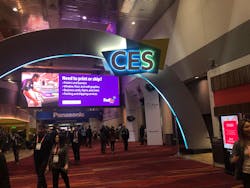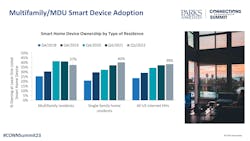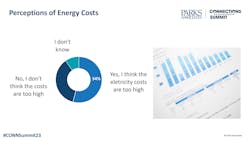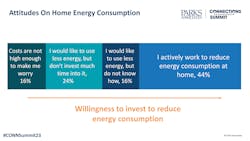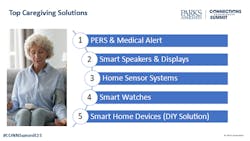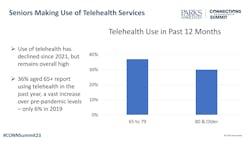CES Trend Check: Smart Homes, Smart Apartments, Interoperability, Energy, Wellness and More
This article originally appeared in the February 2023 issue of Security Business magazine. When sharing, don’t forget to mention Security Business magazine on LinkedIn and @SecBusinessMag on Twitter.
The annual CONNECTIONS Summit CES industry event hosted by research firm Parks Associates focuses on new trends, emerging technology and standards, new business models, and partnerships impacting the connected home.
Here’s a recap of the top trends covered during the sessions at the 17th edition of the event:
Expanding Broadband
The first session focused on issues driving home networking technology, legacy, and emerging usage models, as well as how the industry addresses fragmentation, privacy and security, and value-added services. Moderated by Parks Associates VP of Research Jennifer Kent, it featured leaders from SAM Seamless Network, Minim Inc., Google, Bitdefender, and CommScope.The foundation of modern living is connectivity, Kent said, noting that consumers are more connected than ever, with an average of 16 devices in the home in 2022 (up from 8.4 in 2015). With consumers working, utilizing entertainment and other healthcare services within their homes, robust internet and connectivity reliability is highly valued. In addition to the growth of connected devices in single-family homes, the MDU (multi-dwelling unit) market is also an area for the growth of broadband services and connected solutions.
“Over the past five years, we have seen growing adoption of smart devices among all segments of the U.S. population,” Kent said. “Residents of multi-family housing – apartment complexes, condos, and other building types – are just as likely to own and use smart home devices as are single-family home residents. A growing number of multi-family properties are offering these devices as amenities for residents – and alsoSmart Apartments
Consumer demand for tech in apartments continues to increase, as well as prop-tech growth and new opportunities to serve the consumer in multi-family environments. A panel including executives from ADT Multifamily, SmartRent, Homebase.ai, Cox Communications, and Dwelo explored the role of IT and support as part of the experience for property managers, building owners, and consumers.
With so many devices making their way into the multi-family and MDU landscape, many new use-cases are being supported, including water leaks and incident detection, and self-guided tours for empty units. Moderator Kristen Hanich, Director of Research for Parks Associates, also highlighted cost savings from smart thermostats and other energy and utility-saving devices.
“Connectivity is a big deal because of reliability and security,” explained Vickie Rodgers, VP and General Manager, Cox Communities, Cox Communications. “Home is everything now – we work and go to school there, so we need more security than before the pandemic, and we need to look at vulnerabilities. If the right investment is not there for connectivity, then the devices do not matter.”
Speakers also discussed consumer expectations and the shifting perspectives around technology, especially at home. “It is not really a ‘smart home’ anymore; it is just the home,” said John Butrim, VP of Multifamily, HOA and Builder for ADT Multifamily. “Most of these things are just expected. It is like renting a car where you still have to stick the key in the ignition – no one wants that anymore.”
New Era of Home Energy: EVs, Solar, Storage
Throughout the day, speakers continued to emphasize the role of energy management in the home experience. Park Associates unveiled new research findings from a consumer survey work revealing that 54% of internet households say their energy costs are too high, 44% are actively working to reduce energy at home, and 16% would like to use less energy but don’t know how (learn more at www.parksassociates.com/report/solar-and-storage).
Key players from GAF Energy, Schneider Electric, Georgia Power Co., Constellation, and Sonnen participated in an interactive panel session“The way in which the inflation reduction act was written, there is a real focus on lower-income households to help reduce electricity costs,” explained Keally DeWitt, VP of Marketing and Public Policy for GAF Energy.
Education for consumers, businesses, and industry is essential to increase familiarity and value of energy efficient and energy management solutions. “We are here to help customers make informed decisions, and a lot of times we have to educate them and ensure they understand what they are getting,” added Tray Leslie, Renewable Development Manager - Customer Engagement, for Georgia Power. “We want to make sure installers are sharing the right information with our customers, and that is a key focus of ours when incorporating solar.”
The panel also touched on the challenges of the home infrastructure, particularly as more Electric Vehicles (EVs) are on the road. Parks“One of the biggest hurdles for EVs is the existing infrastructure in homes,” said Schneider Electric Director of Product Management Chris Keefe. “There is a responsibility for us to see if we can add EVs to the existing equipment and also to get charging at the right time and with the most efficiency.”
It is clear from Parks Associates consumer data that attitudes on energy consumption are changing. Currently 44% of internet households are working to reduce energy, but 16% note they do not know what to do.
Security Devices in Smart Homes
Convenience, safety and energy costs savings have always been the leading drivers of security systems and smart home technology. Parks Associates president and CMO, Elizabeth Parks reported the research firm’s data that shows 40% of internet households have a least one security solution (security system, networked camera or video doorbell) – with the vast majority of them being security systems. Nearly 25% – or about 27 million households – also have professional monitoring.Additionally, the research presented reveals that 64% of add-on devices to a security system are video devices. “Consumers want video, and it provides a great opportunity for providers to bundle video devices with their basic security systems and upsell video device subscriptions,” said Parks.
A panel including Liz Kohler, Founder of Nexion Solutions; Akash Sah, Chief Strategy Officer for Brinks Home; Jen Theobald, Director of Strategic Partnerships for Rapid Response Monitoring; Eric Villines, Head of Global Communications for Anker/eufy; and Andrew Vloyanetes, GM of Amazon Ring, discussed the expansion of home security devices and systems, including the blurred lines between DIY and pro security.
Among the various devices mentioned, Ring debuted a new car dashboard camera at CES (more on page 38), as well as the return of the Ring Peephole Cam. Additionally, the security powerhouse offered CES attendees a first look at “The Always Home Cam” – a mini drone designed to zoom around indoors for mobile security.
Smart Home Interoperability
Interoperability and the Matter standard was a common subject during the Summit, as highlighted during a panel featuring Abe Kinney, Senior Director of Product Management for Alarm.com; Michelle Mindala-Freeman, Head of Marketing and Member Services for the Connectivity Standards Alliance (CSA); Sujata Neidig, Marketing Director for NXP Semiconductors; Leah Page, SVP of Product Strategy and InnovationThe lively panel discussion highlighted partnerships, technology developments, interoperability challenges, and new applications and experiences for consumers as smart adoption continues to move to mass-market adoption.
“Companies need to account for varying demands among different consumer segments,” said Chris White, Research Director for Parks Associates. “Tech-enthusiast consumers and smart home device owners want control, while older consumers and those not yet using smart home devices want automation. These findings underscore the need for a broad approach in smart home app development, with in-depth knowledge of the preferences within each consumer segment.”Interoperability is important to consumers; in fact, Parks Associates research shows 73% of U.S. internet households report that interoperability is important when choosing a smart home device to purchase.
Virtual Care and Independent Living
The emergence of connected health products and monitoring services also opens opportunity, especially with older consumers. The industry is undergoing a shift as seniors who have become accustomed to using new technologies expect to use them as part of their health routines in their homes.Service providers, professional security monitoring and PERS monitoring companies are exploring their potential roles in consumer wellness, remote patient monitoring, and aging with independence. Safety and security are the core values for home services and are key drivers for security and connected health solutions alike.
A panel that included executives from Essence USA, Aided Inc., LG Electronics, OMRON Healthcare, and AARP Services debated the senior and caretaker market, highlighting the role of PERS and independent living solutions.
Through in-depth data analytics, Parks Associates has seen family caregivers and seniors adopt many solutions to enable independence and safety. PERS and medical alert devices are the most common and widely known products to serve this use-case, but are also joined by smart speakers and displays, home sensor systems, smart watches, and smart home devices.
Additionally, the research firm noted an increase in senior use of virtual care services – including telehealth. As of 2022 over one-third of those above the age of 65 reported using a telehealth service in the past 12 months, a vast increase.The Whole-Home Experience
Industry players from Lutron Electronics, Josh.ai, Electronic Caregiver, IVANI, and CEDIA explored the whole home vision for tech across the various ecosystems.
Connected devices provide opportunities for new services like independent living, in-home package delivery, home warranty and technical support. Parks Associates research supports a future of services across the key ecosystems in the home, as well as integration between ecosystems.
“A lot of times, those of us in the ‘smart home’ get a little stuck,” Kent explained. “We can be really focused on core smart home devices, like video doorbells, cameras, locks, and thermostats; or the entertainment folks are focusing really tightly on smart TV and streaming media; and the health folks are focusing on vital sign sensors in their smart watches. The vision of the smart home that knows us, that is helpful, that is relevant, that maybe saves us money, and makes us healthier is still out there. There is an immense opportunity to create meaningful connections between silos.”
About the Author

Rosey Sera
Rosey Sera is Senior PR & Marketing Manager for Parks Associates
